Israel Aircraft Industries
Lavi
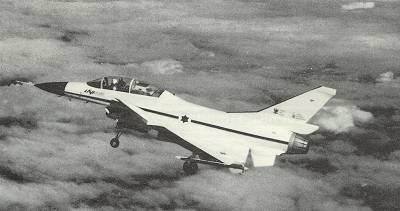
Lavi B01 during first flight; note foreplane angle.
Israel Aircraft IndustriesLavi |
 Lavi B01 during first flight; note foreplane angle. |
In 1968, when France embargoed fifty Dassault Mirage 5 fighters ordered and paid for by Israel, it was decided to build a local, unlicensed copy as the IAI Nesher. Israel determined to rely as little as possible on imported aircraft to supply its air force, resulting in the developed IAI Kfir. While adequate, these would need to eventually be replaced with a more modern, capable aircraft. In 1980 a program was initiated for an interdiction and close support aircraft to replace the Kfir and American-acquired A-4 Ahit aircraft. This aircraft would also be capable of defending itself against enemy aerial opposition. A two-seat combat-capable training variant was also planned, which would replace F-4 Kurnass aircraft used in the training role. First referred to as the Super Kfir, then the Arye, it became known as the Lavi.

The Lavi used a configuration similar to that of the then-General Dynamics F-16 Fighting Falcon: single-engine, single-tail, with underslung inlet, bubble canopy and wingtip-mounted missiles. However, it was not a copy, being somewhat smaller and featuring a low-set delta-wing with 54 degrees of leading-edge sweepback and canard foreplanes instead of a conventional tail. Dual seats were designed in from the outset, as it was felt that it would be much easier to convert this design to the single-seat configuration, rather than vice-versa. Twenty-two percent (by weight) of the aircraft consisted of carbonfibre composites, including the wings and canards. Composite design was by the American Grumman company. The Lavi was planned as a Contol-Configured-Vehicle, whereby high performance is achieved by making the aircraft inherently unstable and flyable only via computerized control. The Lavi utilized advanced fly-by-wire control system, fire-control radar, electronic countermeasures, HOTAS, navigation, and weapons delivery system. The cockpit layout and design was influenced by a committee of which included combat pilots, and measurements were taken of many current air force pilots in order to achieve a perfect fit.
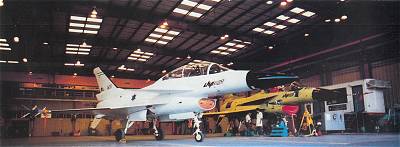
Unfortunately for the IDF/AF, Israel was in an economic downturn and was dependent on American financial backing for the Lavi. Inevitable cost escalations, combined with American fears that the Lavi would compete directly with exported US aircraft brought pressure to bear on the Israeli government to terminate the program. With only the first two prototypes complete, the Lavi was narrowly cancelled on 30 August 1987. Some components of the first two prototypes were utilized in completing the third airframe as a private-venture technology demonstrator (TD). The second prototype was put on museum display, but the first prototype, along with the unfinished fourth and fifth airframes, were melted down for scrap. The TD was utilized for some time as a flying testbed for developing the advanced avionics systems of the Lavi for use in other applications. One of these, allegedly, is the Chinese CAC J-10 fighter, which bears a striking resemblance to the Lavi. Ultimately, Israel obtained more American F-15 and F-16 aircraft to make up for the Lavi requirement, but Israel still remains without a true homegrown fighter aircraft.
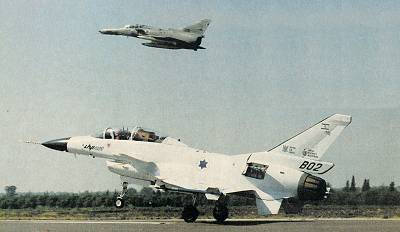
Timeline
| Specifications | Lavi |
| Designer(s) | ? |
| Mission Type | Close air support, interdiction, strike; secondary air defense; later used as technology demonstrator |
| Powerplant | 1 x 12,500 lb (5,670 kg) s.t. Pratt & Whitney PW1120 turbojet, 18,600 - 20,620 - 20,723 lb (8,437 - 9,353 - 9,400 kg) reheated s.t. |
| Dimensions | |
| Span | 28 ft 9.67 in (8.87 m) |
| Length | 47 ft 9.67 in (14.57 m) |
| Height | 15 ft 8.25 in (4.78 m) |
| Wing area | 355.75 sq ft (33.05 m2) |
| Weights | |
| Empty | 15.305 - 15,498 lb (6,942 - 7,030 kg) |
| Basic Take-off | 22,024 lb (9,990 kg) |
| Max | 37,478 - 40,500 - 42,500 lb (17,000 - 18,370 - 19,277 kg) |
| Performance | |
| Max speed | 921 mph above 36,000 ft (1,482 km/hr above 11,000 m) (Mach 1.80 - 1.85) 1,222 mph @ high altitude (1,965 km/hr @ high altitude) (Mach 1.85) |
| Cruise speed | ? |
| Penetration speed, low | 619 mph (997 km/hr) with 2 x wingtip AAMs & 8 x 750 lb M117 bombs 687 mph (1,106 km/hr) with 2 x wingtip AAMs & 2 x 2,000 lb Mk 84 bombs |
| Initial climb rate | ? |
| Service ceiling | ? |
| Combat radius | |
| Range | ? |
| Endurance | ? |
| Turn rate (Mach 0.8, 15,000 ft [4,575 m]) | 13.2 deg/sec sustained, 24.3 deg/sec max |
| Max roll rate | 300 deg/sec |
| Take-off run | c. 1,000 ft (305 m) |
| g limit | |
| Armament | |
| Crew | B01, B02: One B03 TD: two |
| User | Israel (IDF/AF, not operational) |
| Number built | Three, plus two partially built |
| Construction Numbers | B01, B02, B03, B04, B05 |
| Serial Numbers | ? |
| Test Pilots | Menachem Shmul |
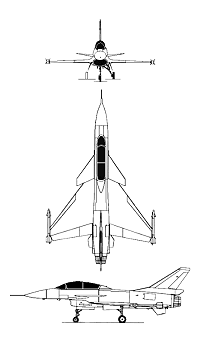 Two-seat Lavi |
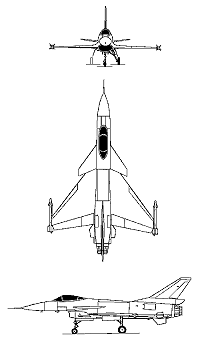 Single-seat Lavi |
Additional Information
Web Links
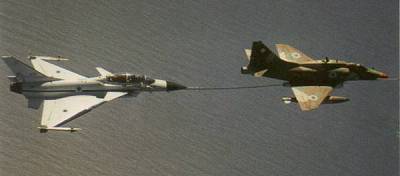
Sources
| [ | Home | | | About | | | Contact | | | Top | ] |
© 1997-2005, Robert Beechy
http://fire.prohosting.com/uncommon/aircraft/lavi/index.html
Originally posted 10 June 1999
Modified: 01/01/2005